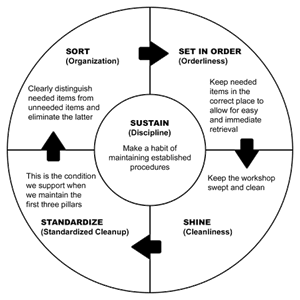Webinar Registration: The P2G Advantage
Webinar Registration: The P2G Advantage LEARN MORE
Data-Driven Warehousing: 10 Steps to Organize Your Warehouse for Optimal Efficiency
Alex Selwitz, Director of Digital Marketing at Red Stag Fulfillment

Unlocking a warehouse's potential starts with impeccable organization. Imagine a well-oiled machine, where inventory seamlessly flows, driven by efficient logistics. Yet, with ever-shifting stock, maintaining this order can seem Herculean.
Fortunately, cutting-edge tools and invaluable data provide a lifeline, empowering warehouses to optimize their organizational prowess. With a staggering annual expenditure of $10 billion and a promising upward trajectory, automation is revolutionizing how we manage and streamline our warehouses. However, this impressive arsenal of tools and data must march hand in hand with lean strategies that actively safeguard the bottom line.
Poor warehouse organization is more than a mere nuisance — it's Pandora's box of issues. Damaged inventory and work-related mishaps burden your team. In 2021, transportation and warehousing accounted for over 235,000 non-fatal injuries, underscoring the urgent need for prioritizing organization. Boosting efficiency and minimizing accidents become paramount.
The good news? Warehouse management systems, inventory management systems, and automation tools are witnessing record adoption. Companies possess the technology and data needed to enhance their organization. The following 10 steps address common warehousing problems and tackle the root causes of poor organization.
#1: Analyze space usage
Efficiently utilizing warehouse space is crucial, especially when expanding or adding more space is not a viable option due to cost or constraints. To identify underused areas, it's essential to analyze your current warehouse space usage comprehensively.
Begin by calculating the storage area of your warehouse and then determine the volume of all SKUs stored at any given moment. By subtracting this value from the total storage area, you can obtain the measurement of unutilized storage space. This insight is invaluable in optimizing your warehouse's capacity and maximizing storage efficiency.
#2: Store items by size
Storing items by size is a highly effective method to optimize stock organization and maximize storage space utilization. The key is to group similar-sized items together, especially when dealing with unpacked inventory, which should be stored in containers.
To implement this strategy, it is essential to accurately determine the size of the items you store in the warehouse. By categorizing and arranging items based on their dimensions, you create a streamlined storage system that facilitates efficient loading and unloading processes. This approach not only enhances organization but also saves valuable time during warehouse operations.
#3: Use a 5S audit
5S, a lean management strategy rooted in Japanese philosophy, is a powerful tool for enhancing warehouse operations. It comprises five steps: sort, set, shine, standardize, and sustain.

Source: EPA
Optimal inventory organization is among the many benefits this lean management strategy offers. Here’s what it involves:
- sorting and decluttering
- structuring (for example, floor signs, aisle signs, labeling, and tagging)
- cleaning
- establishing standards (plans, workflows, processes, and training)
- monitoring and maintenance.
#4: Place frequently turned items in accessible locations
The Pareto principle (80/20 rule), typically used in economics, can also be applied to warehouses. This principle suggests that approximately 80% of warehouse activities revolve around just 20% of the SKUs. In other words, a small portion of the items you have in storage are accessed more frequently compared to others.
To use this principle in your warehouse and identify the frequently accessed items, categorize your inventory using the ABC analysis. Your inventory can be classified according to the number of shipments, picks, or sales — whichever is most relevant to your warehouse. While the categorization may vary, here’s a general idea:
- Category A: high access frequency
- Category B: moderate access frequency
- Category C: low access frequency
Strategic storage based on these categories can significantly increase operational efficiency. For example, relocating Category A items to more accessible locations, such as lower racks or front aisles, reduces turning time and improves overall workflow.
#5: Pick the appropriate storage system
Maximizing warehouse organization hinges on selecting the most suitable storage system for your specific requirements. Various systems exist, and choosing the right one can have a significant impact on efficiency.
When it comes to higher pick selectivity, selective racking stands out as the optimal choice. This system allows for easy access to individual items or SKUs. With selective racking, each item has its own dedicated space, enabling efficient picking and retrieval processes. It is particularly useful when the ability to quickly and directly access specific items is crucial to your operations.
#6: Remove obsolete inventory
In warehousing, storage space is the most valuable asset. One of the best ways to manage inventory is to eliminate slow-moving or obsolete items.
Inventory management tools provide valuable data that can identify items with minimal activity. These slow-moving items occupy valuable storage space and hinder efficient organization when they take too long to be picked or moved.
To free up space and enhance overall inventory management, it is advisable to take action on these stagnant items. Consider returning them to the vendor for appropriate disposition or selling them at a discounted rate.
Eliminating slow-moving or obsolete items is a proactive approach that allows warehouses to maximize their storage capacity, optimize inventory turnover, and maintain a well-organized environment.
#7: Use analytics for accurate demand forecast
Accurate demand prediction plays a vital role in effectively organizing stock within a warehouse. By leveraging predictive analysis, warehouses can draw demand patterns for each quarter of the year, enabling strategic stock reorganization based on forecasted demand.
Investing in analytics tools within warehouse management systems is crucial for obtaining reliable demand forecasts. These tools utilize data-driven insights to generate predictions. The accuracy of these forecasts relies on the system's access to comprehensive data. The more data available, the more precise the predictions.
To continuously improve the demand forecasting process, it is essential to compare the forecasted demand with the actual data at the end of each quarter. This evaluation provides valuable feedback and insights for refining future predictions and enhancing stock organization strategies.
#8: Reserve floor only for active inventory
A lot of warehouse disorganization and clutter results from inventory lying on the warehouse floor. To mitigate this issue, it is crucial to reserve the floor space exclusively for inventory coming in or going out.
Upon arrival, pallets or items should be promptly stored in their designated locations, ensuring that the floor remains clear. By immediately storing items, warehouses can prevent the accumulation of inventory on the floor, leading to improved organization and more efficient use of space.
Not only does this practice enhance organization, but it also prioritizes safety. A clutter-free floor reduces the risk of collisions between workers or equipment. It allows for unobstructed movement for both vehicles and personnel, creating a safer working environment.
#9: Monitor inventory movement
Maintaining real-time inventory tracking through a warehouse or inventory management system is essential for effective organization. By continuously monitoring the storage process, warehouses can promptly identify any issues with organization and placement.
Tracking when and how inventory is stored provides valuable insights into the efficiency and effectiveness of the warehouse's organization system. It enables early detection of potential issues, allowing for timely intervention and resolution before they escalate into larger problems.
#10: Aggregate data from all systems
Data answers most of the issues your warehouse may be facing. However, relying on a single source of data can limit the insights. Aggregating data from multiple sources, in addition to warehouse management, can draw a clearer picture of overall warehouse efficiency and organization.
Integrate data from various tools you utilize to run the warehouse—for example, resource planning, logistics management, vendor management, and payroll. Use an Artificial Intelligence (AI)-powered analytics tool to integrate and analyze all the data. By leveraging AI technology, warehouses can unlock valuable patterns, trends, and correlations within the integrated data, leading to enhanced decision making and optimization of organizational strategies.
Make warehouse organization simpler with the right tools
In the quest for efficient warehouse organization, employing the right tools and equipment plays a crucial role. Properly organized inventory is not only easier to manage but also facilitates safe and seamless movement, aligning with the just-in-time model prevalent in modern supply chains.
The integration of powerful analytics tools, coupled with automation technologies like warehouse robotics, has the potential to revolutionize warehouses into highly organized and optimized segments of the supply chain. These technologies enable advanced data analysis, precise inventory tracking, and streamlined processes, leading to enhanced efficiency and productivity.
With private warehouses growing exponentially, investing in these technologies is necessary to stay competitive.
About the Author
Alex Selwitz is the Director of Digital Marketing for Red Stag Fulfillment, an eCommerce fulfillment warehouse that was born out of eCommerce. He has years of experience in eCommerce and digital marketing. In his free time, Alex enjoys playing guitar and learning about new trends in the digital world.




